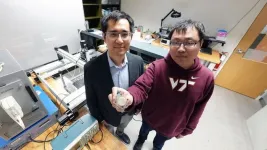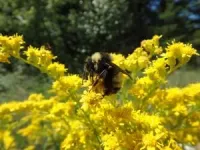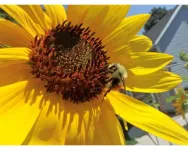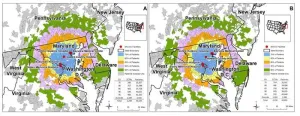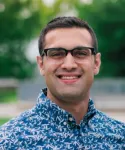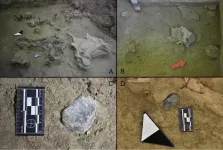(Press-News.org) Medical procedures capable of moving cells inside the body without making incisions have unique benefits. From faster recovery times to less trauma impacting the body, the list of reasons to do surgery without scalpels is growing with the technology used to perform noninvasive treatments.
A new method that might be available in the future is coming to life through research conducted by Zhenhua Tian’s team. The assistant professor in the Department of Mechanical Engineering is using tube-shaped acoustic energy to capture tiny biological materials such as cells and bacteria, moving the captive particles without touching them. The work has earned him a National Science Foundation Faculty Early Career Development Program (CAREER) award, reserved for early-career faculty who have the potential to serve as academic role models in research and education while building a firm foundation for a lifetime of leadership.
Tian’s team will use the $649,000 in funding from the award to further develop its work using acoustic energy to create invisible beams capable of trapping, translating, and rotating objects.
Three beams are better than one
The sounds that reach our ears are transmitted on waves of energy, but not all sounds can be heard by humans. Even if acoustic energy isn't carrying our favorite song, it can perform other tasks.
Tian’s team works with one such set of sound waves called ultrasound waves. When the researchers deploy these waves through something called an acoustic vortex beam, it creates an invisible, hollow energy vortex. This miniature controllable energy tornado functions tweezers: When an object in the center of the vortex is surrounded by acoustic energy, the sound waves hold the object firmly.
While one beam can surround and capture an object, three crisscrossing beams working together create a small capture area, enabling very precise movement of the object suspended in the energy vortex. This three-beam approach can be wielded in different ways, but the result is an invisible tool, operated by acoustics, that can grab, turn, and rotate tiny objects.
To increase the precision with which objects can be moved, Tian's team has also added a robotic arm that holds the acoustic emitter. While the crossed beams hold a particle, the robotics move the particle along paths.
Acoustic energy also can travel through solid objects, which means the beams created by Tian's team can pass through muscle and bone without cutting into it. This might be a particle on a lab bench or it might be a blood clot in someone's body.
Beyond lasers and magnets
Noninvasive approaches to moving biological matter such as Tian’s have been explored by other means. The 2018 Nobel Prize in Physics was awarded for optical tweezers, where the developers were able to use focused optical energy, essentially lasers, in the way Tian’s team now uses acoustics for biological and biomedical applications. However, optical energy is less optimal than acoustic when it comes to manipulating objects that are shielded by opaque barriers such as tissues and skulls.
“Using that method, you cannot efficiently manipulate a large object,” said Tian. “A 1-micrometer object can be moved easily, but for an object of several millimeters, using lasers is not an efficient method for moving it around. In contrast, the audio output from a cellphone is sufficient to perturb millimeter-scaled objects."
Tian added, “The acoustic energy can also travel through materials, which means the acoustic vortex beams can pass through a barrier to move an object behind it. This is important for biomedical applications where noninvasive surgery might be needed.”
Magnetics also have been explored for object manipulation. Magnets are currently in use for surgery with magnetically guided needles and other applications, and there have been successes with those approaches. Of course, the use of the magnetic method requires the object to be made of specific materials that strongly respond to magnets.
“Acoustic tweezers are unique because objects of various materials in gas, liquid, and solid phases can be manipulated in a number of applications,” said Tian.
Bioprinting with living cells
Another possible application for invisible acoustic tweezers is bioprinting with living cells. Being able to precisely place cells could be a future method for
Developing tissue models for biomedical research
Manufacturing tissue replacements for regenerative medicine
Creating new techniques for existing technology such as stereolithography and inkjet bioprinters, but with more precision
As one of the objectives of the CAREER awards is leading advances in research and education, Tian’s team anticipates transforming the acoustics research findings into easy-to-use tools that can be readily adopted by biomedical researchers and by doctors for clinical applications. Motivated by the desire to bring more effective means of both diagnostics and therapeutics to the world, Tian’s team hopes to produce a set of methods that will offer a host of new applications in science and health care.
END
Zhenhua Tian receives National Science Foundation CAREER award to develop invisible acoustic tweezers
The ability to precisely move small objects such as embryos, cells, and bacteria without physical contact could be a valuable tool for health care.
2024-05-22
ELSE PRESS RELEASES FROM THIS DATE:
Community science volunteers can set scientific world abuzz with new bumble bee sightings
2024-05-22
TORONTO, May 22, 2024 – Community science volunteers – laypeople with an interest in bees and conservation – significantly contribute to the scientific knowledge of native bumble bees across Canada and the United States, finds a new study by York University.
It’s buzz worthy confirmation that community science programs can play an important role in monitoring the changing distributions of bumble bees and more. Community scientists have importantly also detected several at-risk or endangered species in unexpected locations, including the rusty-patched bumble bee and the gypsy cuckoo bumble bee. Trained scientists often haven’t seen some ...
Proximity to a cancer center contributes to cancer stage at diagnosis, study finds
2024-05-22
Location, race and insurance status play a significant part in the odds of a patient being diagnosed with early-stage or late-stage cancer, according to a detailed medical records analysis of more than 94,000 patients with cancer by researchers at the Johns Hopkins Bloomberg School of Public Health and the Johns Hopkins Kimmel Cancer Center.
Patients who lived farther away from a facility designated a comprehensive cancer center (CCC) by the National Cancer Institute (NCI) and who received only a diagnosis or only treatment at the center had higher than average odds of a late-stage diagnosis, ...
Study suggests it may be safe to de-escalate surgery in middle-aged breast cancer patients
2024-05-22
Surgery involving sentinel lymph node biopsy for middle-aged women with estrogen receptor-positive (ER+) breast cancer may do more harm than good, according to a new study led by University of Pittsburgh and UPMC Hillman Cancer Center researchers. The team used a novel artificial intelligence pipeline developed by Realyze Intelligence, a UPMC Enterprises portfolio company, to analyze electronic health records.
The findings, published today in JCO Clinical Cancer Informatics, suggest that clinical guidelines for de-escalating surgery in women aged over 70 years with early-stage ER+ breast cancer may be safely ...
Eating more ultra-processed foods tied to cognitive decline, stroke
2024-05-22
MINNEAPOLIS – People who eat more ultra-processed foods like soft drinks, chips and cookies may have a higher risk of having memory and thinking problems and having a stroke than those who eat fewer processed foods, according to a new study published in the May 22, 2024, online issue of Neurology®, the medical journal of the American Academy of Neurology. The study does not prove that eating ultra-processed foods causes memory and thinking problems and stroke. It only shows an association.
Ultra-processed foods are high in added sugar, fat and salt, and low in protein and fiber. They include soft drinks, salty and sugary snacks, ...
What factors predict when older adults will stop driving?
2024-05-22
MINNEAPOLIS – What factors lead older adults to stop driving? A new study followed older adults who had no memory or thinking problems to examine this question. The study is published in the May 22, 2024, online issue of Neurology®, the medical journal of the American Academy of Neurology.
“Alzheimer’s disease develops over a long time—people may have a 10- to 15-year period where they have no symptoms, but the disease process is developing in the brain,” said study author Ganesh M. Babulal, PhD, OTD, of Washington University School of Medicine in St. ...
Subtle cognitive decline precedes end to driving for older adults
2024-05-22
One of the thorniest decisions facing older adults is when to give up their keys and stop driving. A new study by researchers at Washington University School of Medicine in St. Louis could provide guidance in helping seniors plan ahead. The researchers found that impaired cognitive function foreshadows the decision for many seniors to stop driving — more so than age or molecular signs of Alzheimer’s disease. Even very slight cognitive changes are a sign that retirement from driving is imminent. Further, women are more likely to stop driving than ...
Irina Petrache, MD, ATSF, commences term as President of the American Thoracic Society
2024-05-22
May 22, 2024 – Irina Petrache, MD, ATSF, today added president of the American Thoracic Society to her list of accomplishments. The announcement came on the heels of the Plenary Session at the ATS 2024 International Conference. The slate of officers to serve on the Society’s Executive Committee for the 2024-2025 term consists of the following:
Irina Petrache, MD, ATSF, Incoming President
Dr. Petrache is professor of medicine at National Jewish Health and at the University of Colorado. She also serves as chief of Pulmonary, Critical Care and Sleep Medicine, associate ...
Beach erosion will make Southern California coastal living five times more expensive by 2050, USC study predicts
2024-05-22
Contact: Nina Raffio, raffio@usc.edu or (213) 442-8464
Rising sea levels and urban development are accelerating coastal erosion at an alarming rate in Southern California with significant ripple effects on the region’s economy, a USC study reveals.
The study, published in Communications Earth & Environment, predicts that Southern California’s coastal living costs will surge fivefold by 2050 as a direct result of beach erosion. This erosion will require more frequent and costly beach nourishment projects to maintain the state’s treasured shorelines, consequently driving up the cost of living along the coast.
“Our ...
Mount Sinai experts to present new research on long COVID, lung cancer, asthma, sleep apnea, and more at ATS 2024 International Conference
2024-05-22
World renowned pulmonologists and experts in respiratory medicine from the Mount Sinai Health System in New York City will present new research at the American Thoracic Society (ATS) 2024 International Conference in San Diego from May 17–May 22. Please let me know if you would like to coordinate an interview about their work. Mount Sinai doctors and researchers are also available to comment on breaking news and trending topics.
Sessions and Symposiums
(All abstracts listed below are under embargo until the scheduled start ...
Ancient people hunted extinct elephants at Tagua Tagua Lake in Chile 12,000 years ago
2024-05-22
Thousands of years ago, early hunter-gatherers returned regularly to Tagua Tagua Lake in Chile to hunt ancient elephants and take advantage of other local resources, according to a study published May 22, 2024 in the open-access journal PLOS ONE by Rafael Labarca of the Pontifical Catholic University of Chile and colleagues.
Multiple archaeological sites are known from the region of Tagua Tagua Lake in central Chile, representing some of the earliest known human settlements in the Americas. In this study, Labarca and colleagues report ...
LAST 30 PRESS RELEASES:
Numbers in our sights affect how we perceive space
SIMJ announces global collaborative book project in commemoration of its 75th anniversary
Air pollution exposure and birth weight
Obstructive sleep apnea risk and mental health conditions among older adults
How talking slows eye movements behind the wheel
The Ceramic Society of Japan’s Oxoate Ceramics Research Association launches new international book project
Heart-brain connection: international study reveals the role of the vagus nerve in keeping the heart young
Researchers identify Rb1 as a predictive biomarker for a new therapeutic strategy in some breast cancers
Survey reveals ethical gaps slowing AI adoption in pediatric surgery
Stimulant ADHD medications work differently than thought
AI overestimates how smart people are, according to HSE economists
HSE researchers create genome-wide map of quadruplexes
Scientists boost cell "powerhouses" to burn more calories
Automatic label checking: The missing step in making reliable medical AI
Low daily alcohol intake linked to 50% heightened mouth cancer risk in India
American Meteorological Society announces Rick Spinrad as 2026 President-Elect
Biomass-based carbon capture spotlighted in newly released global climate webinar recording
Illuminating invisible nano pollutants: advanced bioimaging tracks the full journey of emerging nanoscale contaminants in living systems
How does age affect recovery from spinal cord injury?
Novel AI tool offers prognosis for patients with head and neck cancer
Fathers’ microplastic exposure tied to their children’s metabolic problems
Research validates laboratory model for studying high-grade serous ovarian cancer
SIR 2026 delivers transformative breakthroughs in minimally invasive medicine to improve patient care
Stem Cell Reports most downloaded papers of 2025 highlight the breadth and impact of stem cell research
Oxford-led study estimates NHS spends around 3% of its primary and secondary care budget on the health impacts of heat and cold in England
A researcher’s long quest leads to a smart composite breakthrough
Urban wild bees act as “microbial sensors” of city health.
New study finds where you live affects recovery after a hip fracture
Forecasting the impact of fully automated vehicle adoption on US road traffic injuries
Alcohol-related hospitalizations from 2016 to 2022
[Press-News.org] Zhenhua Tian receives National Science Foundation CAREER award to develop invisible acoustic tweezersThe ability to precisely move small objects such as embryos, cells, and bacteria without physical contact could be a valuable tool for health care.
